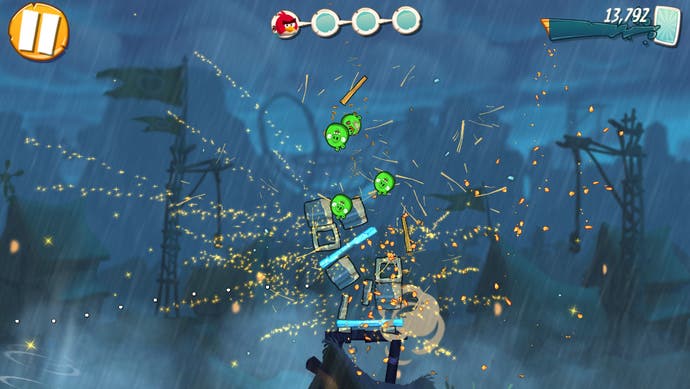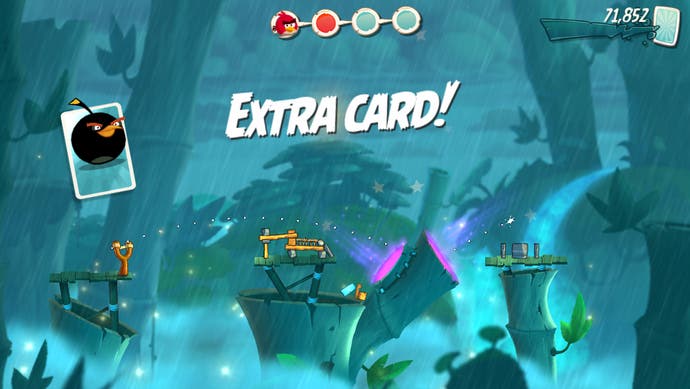Angry Birds 2 review
Winging it.
By declaring the 13th game in a series to be the first proper sequel, Rovio is clearly taking cues from established spin-off factories like Capcom and Square. To its credit, Finnish mobile giant Rovio has actually crafted something that feels like a genuine step forwards for the Angry Birds games as well, introducing new elements that shake up the gameplay in smart ways. It's also, sadly, become much more aggressive in the way it tugs at your purse strings.
It's easy to forget that when it first launched, back in 2009, Angry Birds was one of the good guys in the mobile monetisation battle. You paid a pittance for the core game, then enjoyed months of free updates. The brand became so huge so quickly that no hard haggling was required. No cooldown timers. No waiting for lives to refill or spending gems to continue.
That's all changed now, but to understand how it impacts Angry Birds 2 so negatively it's important to acknowledge what the game also gets right.
At its core, not much has changed. You still twang infuriated avians at green pigs who have sequestered themselves inside teetering constructions of wood, stone and ice. The birds on offer will mostly be familiar - the red one, the yellow triangle one, the blue one that splits in three, the egg-laying one, the big black one that explodes and the Mighty Eagle. There's just one new bird: Silver, who performs a looping divebomb attack.

Structure is where the big change takes place, as each level is now made up of multiple screens, each of which must be cleared in sequence in order to mark the level as complete. Birds are no longer queued up for you, but appear as a hand of cards. Three cards are available at any time, and you can choose whichever one you want to fire, with any others forming a blind deck that randomly replenishes your line-up as it dwindles. The only way to add a new card to the deck is to cause enough destruction to fill a meter at the top of the screen.
There are also new environmental features, such as fans that redirect both birds and debris, portals that will spit objects out elsewhere in the level, and plants that will gobble and spit objects back into play.
The benefit of this shift is that the puzzles that make up each level are now more intricate than before, making greater use of a physics engine that is enjoyably robust. It's often worth waiting a while after a shot to see if any of the chunks of scenery pinging around will help you out with a lucky strike.
It's a gorgeous looking game as well. Rovio's expansion into animated shorts has paid off, with the same attention to detail now soaked into the games. There are dozens of quirky and funny little touches, from the expressive faces on the pigs as they see a bird hurtling towards them, to the way they sometimes fly towards the screen when hit. A huge part of the Angry Birds appeal has always been the sheer fun of demolishing stuff, and that pleasure has never been more silly and sweet.

So why does the game leave such a sour taste? Probably because it now comes with the dreaded countdown timer that makes you wait or pay when you run out of lives, and the way the game sometimes feels like it's conspiring against you.
There's always been a random factor in this series, but it's been cranked up for this sequel. The birds you get will be random. The materials that make up each level will be random, and since there's a greater emphasis than ever on the use of specific birds to destroy specific targets, it means you can find yourself in situations where failure is inevitable.
For instance, you may have to clear four screens worth of pigs to complete a level. That means you have to clear each screen using no more than two birds, preferably one. But if the game decides that the first screen will have stone rather than wood or ice, yet only gives you birds that will bounce off, you're doomed to waste more birds getting to the next screen. Suddenly, those rogue pigs who escape your attacks are an omen of certain doom. The game also likes to hide pigs in balloons, up at the top of the screen, requiring you use another bird to bring them down. There are lots of rather snide tricks used to reduce your stock and once you're behind the curve in terms of bird usage, the odds of scraping it back for victory are small.
That's where spells come in. This is the game's other big new feature, and it's where you feel the cash hoover sucking hardest. Spells are basically one-off power ups that are added to your deck. One turns everything into easily smashable ice. Another rains golden rubber ducks from the sky. There's a chilli pepper that sets one pig on fire and makes him explode, and a raygun that makes every pig swell to enormous size.

These are really fun to use, and not coincidentally vastly improve your chances of beating a level. Naturally, once you've used up the first batch used to introduce a new spell, the only way to get more is to hope you randomly earn one from the destruction meter (unlikely) or just buy some using gems. You can earn these gems, of course, but saving up the tiny amounts won through daily challenges hardly covers the cost of just one power-up.
It's impossible not to see the way that later levels have been calibrated to be just frustrating enough to beat using only the randomly selected standard birds, always quietly (and not so quietly) nudging you towards cashing in gems - and eventually just plain cash - to level the playing field. There are also the obligatory prompts and reminders at suitable points in the game: hey, why not watch an ad to earn an extra bird, or use some gems to continue from where you failed? Go on, just this once. The further you get into the game, the more each level becomes an uphill struggle that allows for no mistakes, and urges payment to keep going. It's not the most aggressive free-to-play game out there, nor is it the most cynical, but it's still relentless and wearying.
It's a real pity, since the core gameplay of Angry Birds 2 is still a lot of fun. There's a primal catharsis to the concept that clearly resonates with players, and with a greater emphasis on physics, stronger puzzle design and a lovely cartoon style that is more alive than ever, this should have been Rovio's moment to shine. It couldn't help adhering to the same ruthless monetisation that drives Clash of Clans, Game of War and dozens of others though. For all its lavish presentation, Angry Birds 2 seems more interested in making you pay than enjoyable play.


